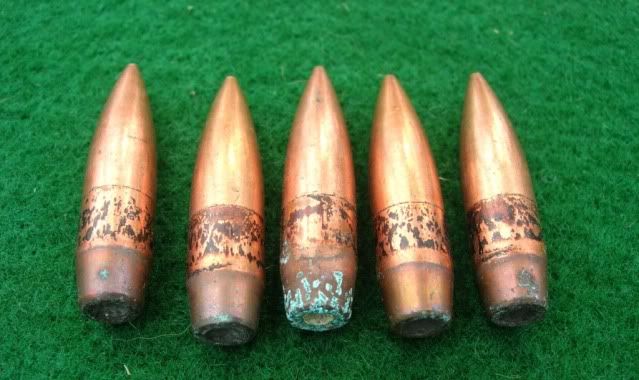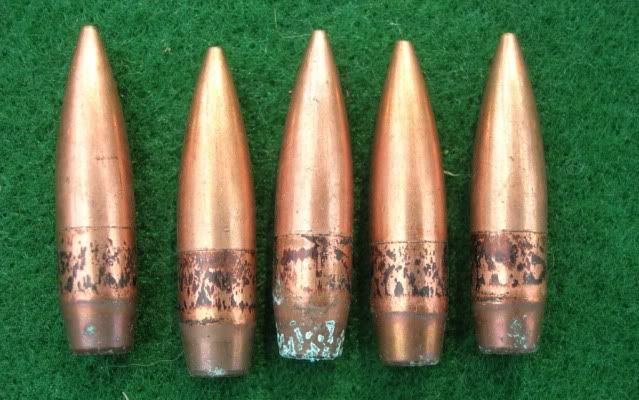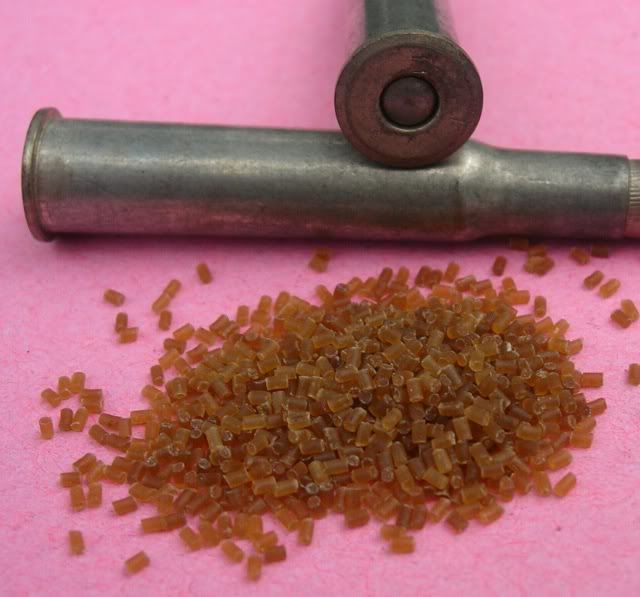

 The Accurate Reloading Forums
The Accurate Reloading Forums  THE ACCURATE RELOADING.COM FORUMS
THE ACCURATE RELOADING.COM FORUMS  Guns, Politics, Gunsmithing & Reloading
Guns, Politics, Gunsmithing & Reloading  Reloading
Reloading  IMR 4895 Problem
IMR 4895 ProblemGo  | New  | Find  | Notify  | Tools  | Reply  |  |
| One of Us |
Decided to start up the Dillon recently and going through my powder cans(8lbs) decided to use subject powder. Well, opened lid and poured into powder thrower and a very nasty smelling fine dust came back at me. It was brown in color and even had a sour taste/acid to it. I decided not to use, but curious if anyone has ever experienced this issue. Can is some three years old, but I have other powders that old or older and have never had this problem. I am not going to use it, but just curious why this would happen?? | ||
|
| one of us |
3 years is a very short time for powder to go bad. Might be a storage problem? High heat? This 1 can (photo) of older Dupont powder went bad, 2 other cans are fine, stored right next to each other. Can not see the lot number on the bad can of IMR 4895.   | |||
|
| One of Us |
Several years ago converted my house attached garage to my "space" so to speak and it is heated in the winter time and cooled in summer time. Temperature varies from low of 65 to high of some mid 70's in summer months. That is a fairly stable temperature range throughout the year and none of my other powders have displayed any problems. I bought this 8 lb cannister at gunshow and have bought powder from same fellow before and no problems. I have some yellow jackets in the back of my property and figured I would give them a dose of this powder and stand back. Did this last year and used about a coffee cup worth and after lighting it looked like a rocket blast and lots of little wings and things going skyward. | |||
|
| one of us |
High heat is a common reason. The propellant may not have been rinsed well enough during manufacture resulting in too much residual nitric acid. | |||
|
| one of us |
LOL - I would have liked to have seen that! ________ Ray | |||
|
| One of Us |
What kind of groups did you get with those yellow jackets and that load of 4895? | |||
|
| one of us |
243winxb one of us what did IMR have to say about that?? thats nasty | |||
|
| One of Us |
It is very unusual for powder to go bad in three years, but given enough heat exposure, why not? The gross indications of powder deterioration are the bitter smell due to NOx, red powder granules, fuming gas emissions, others have said “red gas”. By the time you see this the powder went bad a long time before. Half of all the surplus IMR 4895 I purchased went bad. The first 16 lbs, I used up eight pounds quickly. For whatever reason, I pulled the bullets on some of that stuff and found green corrosion on the bases of the bullets. Similar to these pull down bullets from old US ammunition. Not the horrible one, but the small green spots.   I don't remember what US ammunition these came off, I pulled them decades ago, might have been WWII ammunition that came back from China. The last eight pounds, it sat around. When I opened the bottle top, it smelled bitter. Red dust flew around. I gave it to a machine gunner guy. He put it in the laundry room. Passing by the laundry room he tossed soiled shorts at the hamper, but missed. The short ended up on top of the powder bottle. Overnight, acid gas from the bottle ate holes in the shorts!! :what: This freaked my friend and he poured the stuff out over his lawn. Since then I have had more surplus 4895 powder from a different vendor go bad in the case. Green corrosion on the bottom of the bullets and cracked case necks. This powder never smelt bitter at all. I shot this powder in highpower matches and it shot exceptionally well, but case necks cracked after firing. I also received “funny” retorts and the occasional sticky extraction. The longer the ammunition sat around the more cases necks would split when fired. In time virtually all of the remaining 700 loaded cases experienced cracked case necks without the stresses of firing. From what I had read on the internet, which is a repeat of what is said in gun magazines, powder has an “indefinite” shelf life. Remember reading statements to the effect that powder lost energy as it got old, making it essentially benign. Then I ran into an Insensitive Munitions expert. This IM expert explained that powder deteriorates from the day it leaves the factory. Nitrocellulose decomposes through the reduction-oxidation process. Called Redox. The expert said “The molecular stability of the functional groups on the organic chain determine the life time of the nitrocellulose molecule.” All ionic compounds, water is the main offender because it is always in air, react with those bonds and accelerates the deterioration of the powder. The bottom line is that nitrocellulose is a high energy molecule that wants to become a low energy molecule. Heat accelerates the deterioration/decomposition of powder and the rate is directly proportional to the Arrhenius equation. If you read in the Insensitive munitions literature, you will see that they use high temperature to accelerate aging of smokeless propellants. Double based powders have a reduced lifetime compared with single base. Double based powders have nitroglycerin (NG) in the grain. Nitroglycerine remains a liquid and it migrates within the grain to react with the NO bonds on the nitrocellulose, increasing the rate of reduction-oxidation reaction. All ionic compounds react with those bonds and accelerate the deterioration of the powder. Rust is bad as ferric oxide is ionic. Water is ionic and it is ever present in the air. Because water reacts in a negative way with smokeless propellants, quality ammunition is manufactured in humidity controlled environments. Between 40% and 20% humidity. They don't go lower due to electro static discharge concerns. The best storage condition for powders is arctic. Cold and dry. Due to the migration of NG within double based powders, the surface of the grain will become rich in NG even though the total energy content of the propellant has decreased. This will cause changes in the burn rate, and can cause pressures to spike. The surface of nitrocellulose powders also change as the powder deteriorates, and it changes unevenly. This creates conditions for erratic burn rates. Burn rate instability is undesirable and can cause explosive conditions in firearms. In retrospect, this explains the “funny” retorts I experienced and the sticking cases. It is an extremely rare occurrence, but old ammunition has caused rifle Kabooms. When I discussed this with a machine gunner buddy, he said that explained the two top cover explosions he had with old Yugoslavian 8 MM ammo. I think it explains the Garand kaboom in the link below. NOx gas is a mix of compounds all of which are reactive. http://en.wikipedia.org/wiki/NOx http://en.wikipedia.org/wiki/Nitrogen_oxide When smokeless propellants break down NOx gas is released. Nitric acid gas is only produced in the presence of water, because it requires a hydronimun ion, but there is plenty of water in air. Section from the Propellant Management Guide: Stabilizers are chemical ingredients added to propellant at time of manufacture to decrease the rate of propellant degradation and reduce the probability of auto ignition during its expected useful life. As nitrocellulose-based propellants decompose, they release nitrogen oxides. If the nitrogen oxides are left free to react in the propellant, they can react with the nitrate ester, causing further decomposition and additional release of nitrogen oxides. The reaction between the nitrate ester and the nitrogen oxides is exothermic (i.e., the reaction produces heat). Heat increases the rate of propellant decomposition. More importantly, the exothermic nature of the reaction creates a problem if sufficient heat is generated to initiate combustion. Chemical additives, referred to as stabilizers, are added to propellant formulations to react with free nitrogen oxides to prevent their attack on the nitrate esters in the propellant. The stabilizers are scavengers that act rather like sponges, and once they become “saturated” they are no longer able to remove nitrogen oxides from the propellant. Self-heating of the propellant can occur unabated at the “saturation” point without the ameliorating effect of the stabilizer. Once begun, the self-heating may become sufficient to cause auto ignition. The Armed Forces have stockpile surveillance programs but each Service does theirs a little differently. If you want to see all the different tests the military uses to determine propellant characteristics, look at Mils Std 286 Propellants, Solid: Sampling, Examination and Testing to be found at https://assist.daps.dla.mil/quicksearch/. If you look, you will find aging tests. One common test is for powder to be kept at 65 C until it fumes. It if fumes within 30 days it is checked for stabilizer or scrapped. The Navy expert told me a few ways the Navy samples its powders and propellants. If the powder is outgassing nitric gas (as determined by change of color of methly violet paper in contact with the powder (Methly Violet test, or Talliani test)), the stuff is tested to see how much stabilizer is left. If the amount is less than or equal to 20%, the lot is scrapped. Scrapping powders and propellants with this percentage of stabilizer appears to be consistent across all services. Pages 5-11 of the 2003 Army Logistics Propellant Management Guide provide the protocols for testing and subsequent actions for their Stockpile Propellant Program. Basically, all propellant lots are tracked. The trigger for investigation is: "When Master Sample Stability Failure Occurs" The Navy expert provided 'rules of thumb' concerning when to expect problems with double based and single based propellants. The rules of thumb are: Double based powders and ammunition are scrapped at 20 years, single based 45 years. In his words “These 'rules of thumb' are particularly useful when the protocol fails. The protocol can easily fail when workmanship or good housekeeping measures are not followed during manufacture of propellant and/or rocket motor or during storage of the weapon system components, respectively.” The expert suggested that it is likely that surplus military powders are not on the market anymore due to liability issues. The stuff was scrapped because the military decided it was not safe to keep around anymore. For the home reloader, if the powder has turned red, or smells like acid, it is way beyond its safe limits. I am of the opinion that the reason this is not discussed in the popular gun press is because if the shooting community knew that powders had a shelf life, it might effect sales. As we all know, gunwriters are shills for the industry and for decades the shills have been reassuring us that as powder gets old, it becomes benign. I cannot see a reason why industry wants you, the shooter, to be picky about old powders and old ammunition. You might not buy, you might have reservations about buying. It is all about profits you know. The military does not talk about this, but bunkers and ammunition storage areas have gone Kaboom due to old powder. That nitric acid builds up, creates heat, and the stuff blows up. It blows up inside the case or the shell. http://www.liveleak.com/view?i=13c_1205681217 This powder is from a FA 11-1898 30-40 Krag cartridge. Obviously it is bad.   I sent the IM expert the link with this Garand blowup, http://www.socnet.com/showthread.php?p=1344088 and the pictures of my corroded bullets and pulled Krag red powder, and this is what he wrote back: Wow The red color indicates that the stabilizer is depleted and the redox reaction is degrading the nitrate ester. (I assume this is a single base gun propellant, and the nitrate ester is NC.) Please dispose of this powder and ammo supply before it starts to get warm or self-heat (via autocatalytic exothermic reaction). This stuff can be a runaway reaction and spotaneously explode in storage. The cracked case necks are proof that the outgassing of NOx is occurring. The pressure build-up is evidently enough to fatigue the metal at a high stress location in the cartridge case (@ the neck bend). You should also see a bulge in the cartridge base (where the firing pin would strike b/c there is a circular joint crimp there between the two metals). This ammo would explosively vent at the crack if you tried to fire it in a gun. Just like the Garand example you sent. Please discard this ammo. The corroded ammo is the same as above (redox reaction gassing NOx) except this stuff actually got wet too. Water provides a medium for corrosive acid reactions to result. Please discard this ammo. Lessons learned - (1) Ammo has a finite shelf life (2) Ammo can be dangerous More to read if you wish: www.dtic.mil/dticasd/sbir/sbir031/n154.doc This paper discusses most of what I have written, but it has a confusing section where it states that “Suddenly, propellant that has spent its entire life in a configuration that was considered inherently safe from the risk of auto ignition is now bulk packaged and stored in a concentrated mass that may be sufficient to allow auto ignition to occur.” After discussions with the Navy expert I found that the insensitive munitions community has its own myths and legends. There are groups within the IM community who promote the “5 inch” rule. The theory is that for munitions 5 inch and smaller, the thermal mass of the case is sufficient to wick away heat and prevent auto ignition. The Navy expert considers this theory to be bogus and created by self serving individuals who get cash awards when they “extend the shelf life” of propellants. Never doubt the power of greed. http://www.almc.army.mil/alog/...pellant_stab_eq.html | |||
|
| one of us |
Dupont no longer owns IMR, so i did not contact them. If i could have seen the lot number, then i might try.
| |||
|
| One of Us |
I think ATK owns them now. | |||
|
one of us |
Nope, Hodgdon Powder bought IMR a couple years back. ------------------------------------ The trouble with the Internet is that it's replacing masturbation as a leisure activity. ~Patrick Murray "Why shouldn`t truth be stranger then fiction? Fiction after all has to make sense." (Samual Clemens) "Saepe errans, numquam dubitans --Frequently in error, never in doubt". | |||
|
| One of Us |
If you have an old can of powder it does not hurt to call the manufacturer to ask about its age. I called Hercules/Alliant about the age of some of my old cans of Bullseye, Unique, 2400. They did not keep records of lot numbers. So the call did not hurt, did not help either. | |||
|
| One of Us |
Even if the powder looks, acts, and smells normal, it can still lose some of it's uumph over time. The only way to tell is to proof it against some of the same powder of new mfg. over a chrony. If you don't proof it, and are still getting good velocity, etc, I still would not use the data you gain from it with new powder without a careful work up. Aim for the exit hole | |||
|
| One of Us |
Informative read regarding aging powder or powder that may have absorbed moisture. I have about 12lbs of the stuff, but fortunately don't have than many yellow jackets. Believe I will just take it to back of property and spread it over a wide area. I did do a non scientific test on burn rate by using board 12 inches long w/ quarter inch groove in middle and filled evenly and struck match to it. Did same with fairly new 1lb. can and timed both burns. Burn rate was basically same based on just using second hand on wrist watch. No matter, the stuff is going out. While writing this remembered we have some of the sand hornets this summer and they are damn near big enough to ride and I'll see how many of those I can launch into orbit. | |||
|
| One of Us |
Old age is a high price to pay for maturity!!! Some never pay and some pay and never reap the reward. Wisdom comes with age! Sometimes age comes alone.. | |||
|
| one of us |
Deteriorating smokeless powders produce an acidic odor and may produce a reddish brown fume. (Don’t confuse this with common solvent odors such as alcohol, ether and acetone.) http://www.saami.org/specifica...Smokeless_Powder.pdf | |||
|
| One of Us |
My dad had some cans of IMR, dont remember the number, get that way sittin in an upstairs closet. So moisture didnt get to it. At Lake City they stored powder in caves dug into a hill. | |||
|
| Powered by Social Strata |
| Please Wait. Your request is being processed... |
|

Visit our on-line store for AR Memorabilia

